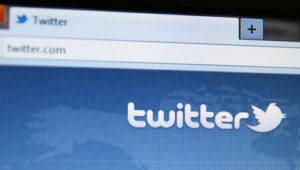The Indiana University applicant knows the meaning of the big envelope versus the little one. A rejection letter needs only a page, but an IU welcome packet comes with a folder’s worth of pages to flip through and rejoice.

Indiana University, however, has tried to find a way to make the gratification of the big envelope a bit more instant.
On the back of a wavy-patterned crimson envelope, the one that might be torn open in a fit of Hoosier hysteria, there is a message printed in large, white type.
“#IUsaidYes”
Through a Twitter hashtag created for the IU Admissions handle, @IUAdmissions, newly accepted students are encouraged to quickly snap a picture of the envelope with their smartphones and post the picture to the social networking site.
IU will then “retweet” and share their celebratory post with the Hoosier Nation.
Sarah Shirley, a high school senior in Lawrence County, tweeted a picture of a piece of pumpkin pie she had sliced to celebrate — the university’s trademark, an overlapping I and U, drawn with whip cream.
Reilly Cosgrove, dressed as a zombie for Halloween, posted a “twitpic” holding up the “#IUsaidYes” envelope. Many of the accepted are even quicker to tweet the moment, because IU will actually send an email telling applicants their acceptance is in the mail, pumping the #IUsaidYes campaign.
#IUsaidYes started during this application cycle as just another way for IU to expand its influence in the social media realm. In this case, students are being indoctrinated before they step onto campus.
Social media sites such as Facebook were designed to bring the college experience to the internet.
For the past several years, IU has been one of the nation’s leading universities in the medium, using it to bring the university to the masses — students of past, present, and future.
See Page 2 for details on who is doing the tweeting at Indiana University (hint: it’s not the president).With more than 81,000 followers of its @IUBloomington account — tops in the Big Ten — IU uses Twitter for a mix of news and entertainment. It shares pictures of the Nearly Naked Mile or a photo essay of “The Squirrels of IU.”
There are also more urgent applications, demonstrated early on the morning of Oct. 27, when the university’s communications staff joined emergency management’s IU Notify system in posting alerts about a man with a knife on campus.
In its lightest and most serious moments, social media can be used for “community building,” according to Mark Land, the head of the university’s communications department and one of IU’s more active fingers on the keyboard in the Twitter-sphere.
“More and more, our students are engaged in social media,” Land said. “We are more conscious than ever that our students are following us.”
Who’s tweeting?
Land, known as @newsland333, has tweeted more than 4,600 times since joining Twitter more than four years ago. He wishes he had thought of the #IUsaidYes idea, but it’s something he can take no credit for.
Land has learned that running a Twitter feed takes a passion for it, including all of the back-and-forth that comes with social media. And no matter how prominent the public figure, Twitter might not always be in their comfort zone.
When Land moved to IU from Cummins, he checked to see if IU President Michael McRobbie wanted to try tweeting.
That was one of their very first meetings, and Land remembers how that conversation began — and quickly ended. “Don’t ever expect me to tweet,” McRobbie told him.
Unlike Purdue President Mitch Daniels, who now has a following of more than 9,000 people for his handle @PurdueMitch, McRobbie doesn’t want to be followed personally.
Land has approached the president a handful of times to see if his attitude has changed, to see if he’s become more comfortable with the idea, but to no avail.
In the meantime, Land and his staff have been more aggressive about trying to give McRobbie a larger presence on the site by tweeting what he’s doing, such as daily tweets about his movements during his trip to Africa in August through the university-wide account.
“He doesn’t have the appetite to do it,” Land said, “but we are not going to force the issue.”
IU’s impact on the Twitter landscape involves few solo personalities on the academic side, rather schools with their own followings.
Bloomington’s School of Public and Environmental Affairs has only 1,200 followers, but it has sent off more than 2,000 tweets during the account’s almost seven-month history, mostly about the accomplishments of faculty and students and what events are happening on campus.
The Kelley School of Business has about 8,500 followers, recently posting a video featuring ex-Hoosier star Cody Zeller as he talked about securing a price-conscious living space, despite his newly found millions in professional basketball.
Sports coaches and players have proved to be much more banter-friendly at IU.
Colorful sophomore point guard Yogi Ferrell, @YogiFerrell11, has accrued almost 40,000 followers, but that’s only a fraction of Coach Tom Crean’s more than 127,000.
Crean’s tweets are a collection of inspirational sayings and Bible verses, while Ferrell, who has tweeted almost 10,000 times since joining the site in November 2010, has a Twitter feed rife with commentary about his escapades hour-to-hour, whether it’s a movie he’s watching or a nap he’s thinking about taking.
Other platforms
Officials at IU are looking for new ways to expand the university’s social media presence.
IU has moved into the image-focused medium with Instagram, and the @IUBloomington account ranked fifth in followers and third for user engagement. The university also has more than 23,000 followers on the site Pinterest.
Much of Land’s efforts are going toward thinking up more campaigns like #IUsaidYes to create engagement between the university and its “followers.”
On Facebook, IUPUI has a “50 Things to Do Before You Graduate” campaign, which asks students to post pictures of themselves doing items on the list, such as playing a sport on campus or visiting “the cube” in the Office of Student Involvement.
It’s all to make college a more “social” experience.
©2013 the Herald-Times (Bloomington, Ind.). Distributed by MCT Information Services
- What does higher-ed look like in 2023? - January 5, 2015
- Are ed-tech startups a bubble that’s ready to burst? - January 1, 2015
- Are MOOCs really dead? - August 28, 2014

